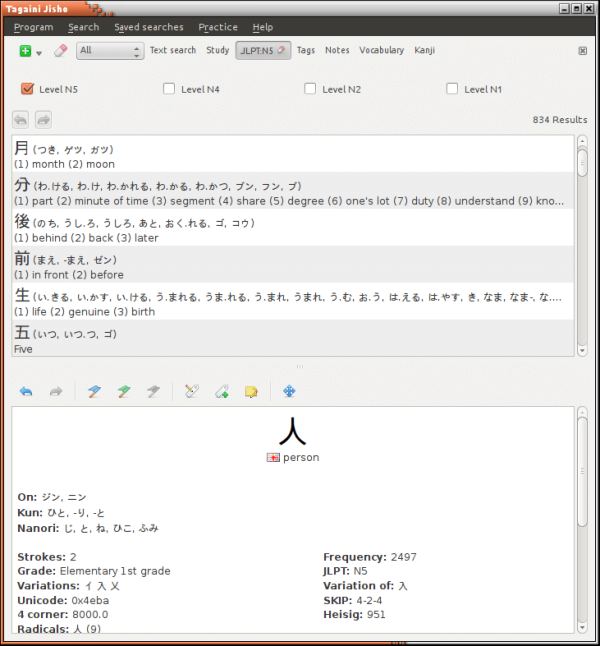Tagaini Jisho is an open source Japanese vocabulary and kanji dictionary that aims at presenting results in a way that makes it easy to create connections in your mind and remember them.
To allow this, it keeps track of all the entries you already know and allows you to tag and add notes to them. It also features kanji drawing animations for more than 6000 kanjis, flashcard-like training, production of paper material for studying, and extended search options for vocabulary and kanjis including part-of-speech and JLPT levels.
Tagaini Jisho makes heavy use of the embedded SQLite database.
Features include:
- Complete Japanese vocabulary and kanji Dictionaries, with more than 140,000 vocabulary and 12,000 kanji entries.
- Kanji dictionary based on kanjidic2 and KanjiVG.
- Powerful search engine with many search parameters: JLPT level, part-of-speech, full wild-card support etc.
- Entries can be marked for study and have a score that evolves as you correctly recognize them.
- Training mode for studied entries, where lowest score entries are more likely to be trained.
- Print feature with connections between studied kanji and vocabulary, in a format that allows both studying and flash-carding (thumb-hideable Japanese part).
- Radical and component-based kanji look-up, including an input method that lets you find almost any kanji, as long as you can recognise some of its components.
- JLPT classifications of vocabulary and kanji.
- A study list that keeps track of all the vocabulary and kanji entries you wish to study.
- Sets let you easily remember any search, allowing you to quickly access queries like “What were the JLPT-2 kanji that I added to my study list this week?”
- Notes and tags can be applied to entries, allowing you to group entries in a way that makes sense to you.
- Hierarchical and ordered lists provide an easy way to classify vocabulary and kanji found in textbooks or to organise them arbitrarily.
- Stroke order animations for more than 6000 kanji.
- Kana panel that allows the study of hiragana and katakana.
- Transparent connection of related entries, including transitive / intransitive verb references, Homophones and Homographs. Tagaini maximises the logical connections between elements of the Japanese language in order to facilitate their memorisation.
- Flash cards for vocabulary and kanji entries that remember which entries you are having difficulty memorising so that Tagaini may display them more frequently.
- Production of printed material, including a handy fold-able booklet to study anywhere.
Website: www.tagaini.net
Support: User Manual
Developer: Alexandre Courbots
License: GNU General Public License v3.0

Tagaini Jisho is written in C++. Learn C++ with our recommended free books and free tutorials.
Return to Foreign Language Tools
| Popular series | |
|---|---|
| The largest compilation of the best free and open source software in the universe. Each article is supplied with a legendary ratings chart helping you to make informed decisions. | |
| Hundreds of in-depth reviews offering our unbiased and expert opinion on software. We offer helpful and impartial information. | |
| The Big List of Active Linux Distros is a large compilation of actively developed Linux distributions. | |
| Replace proprietary software with open source alternatives: Google, Microsoft, Apple, Adobe, IBM, Autodesk, Oracle, Atlassian, Corel, Cisco, Intuit, and SAS. | |
| Awesome Free Linux Games Tools showcases a series of tools that making gaming on Linux a more pleasurable experience. This is a new series. | |
| Machine Learning explores practical applications of machine learning and deep learning from a Linux perspective. We've written reviews of more than 40 self-hosted apps. All are free and open source. | |
| New to Linux? Read our Linux for Starters series. We start right at the basics and teach you everything you need to know to get started with Linux. | |
| Alternatives to popular CLI tools showcases essential tools that are modern replacements for core Linux utilities. | |
| Essential Linux system tools focuses on small, indispensable utilities, useful for system administrators as well as regular users. | |
| Linux utilities to maximise your productivity. Small, indispensable tools, useful for anyone running a Linux machine. | |
| Surveys popular streaming services from a Linux perspective: Amazon Music Unlimited, Myuzi, Spotify, Deezer, Tidal. | |
| Saving Money with Linux looks at how you can reduce your energy bills running Linux. | |
| Home computers became commonplace in the 1980s. Emulate home computers including the Commodore 64, Amiga, Atari ST, ZX81, Amstrad CPC, and ZX Spectrum. | |
| Now and Then examines how promising open source software fared over the years. It can be a bumpy ride. | |
| Linux at Home looks at a range of home activities where Linux can play its part, making the most of our time at home, keeping active and engaged. | |
| Linux Candy reveals the lighter side of Linux. Have some fun and escape from the daily drudgery. | |
| Getting Started with Docker helps you master Docker, a set of platform as a service products that delivers software in packages called containers. | |
| Best Free Android Apps. We showcase free Android apps that are definitely worth downloading. There's a strict eligibility criteria for inclusion in this series. | |
| These best free books accelerate your learning of every programming language. Learn a new language today! | |
| These free tutorials offer the perfect tonic to our free programming books series. | |
| Linux Around The World showcases usergroups that are relevant to Linux enthusiasts. Great ways to meet up with fellow enthusiasts. | |
| Stars and Stripes is an occasional series looking at the impact of Linux in the USA. | |
